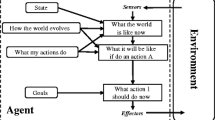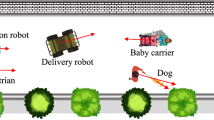Abstract
In complex contexts, people need to adapt their behavior to interact with the surrounding environment to reach the intended destination or avert collisions. Motion dynamics should therefore include both social and kinematic rules. The proposed analysis aims at defining a linear dynamic model to predict future positions of different types of agents, namely pedestrians and cyclists, observing a limited number of frames. The dynamics are defined in terms of artificial potentials fields (APFs) obtained by static (e.g., walls, doors or benches) and dynamic (e.g, other agents) elements to produce attractive and repulsive forces that influence the motion. A linear combination of such forces affects the resulting behavior. We exploit the context using a semantic scene segmentation to derive static forces while the interactions between agents are defined in terms of their reciprocal physical distances. We conduct experiments both on synthetic and on subsets of publicly available datasets to corroborate the proposed model.
Access this chapter
Tax calculation will be finalised at checkout
Purchases are for personal use only
Similar content being viewed by others
References
Ge, S.S., Cui, Y.J.: Dynamic motion planning for mobile robots using potential field method. Auton. Robot. 13(3), 207–222 (2002)
Bounini, F., Gingras, D., Pollart, H., Gruyer, D.: Modified artificial potential field method for online path planning applications. In: 2017 IEEE Intelligent Vehicles Symposium (IV), pp. 180–185 (June 2017)
Xie, D., Todorovic, S., Zhu, S.C.: Inferring dark matter and dark energy from videos. In: 2013 IEEE International Conference on Computer Vision, pp. 2224–2231 (Dec 2013)
Khatib, O.: Real-time obstacle avoidance for manipulators and mobile robots. In: Proceedings. 1985 IEEE International Conference on Robotics and Automation vol. 2, pp. 500–505 (Mar 1985)
Koren, Y., Borenstein, J.: Potential field methods and their inherent limitations for mobile robot navigation. In: Proceedings of 1991 IEEE International Conference on Robotics and Automation, vol. 2, pp. 1398–1404 (Apr 1991)
Ge, S.S., Cui, Y.J.: New potential functions for mobile robot path planning. IEEE Trans. Robot. Autom. 16(5), 615–620 (2000)
Helbing, Dirk, Molnár, Péter: Social force model for pedestrian dynamics. Phys. Rev. E 51, 4282–4286 (1995)
Mehran, R., Oyama, A., Shah, M.: Abnormal crowd behavior detection using social force model. In: 2009 IEEE Conference on Computer Vision and Pattern Recognition, pp. 935–942 (June 2009)
Yamaguchi, K., Berg, A.C., Ortiz, L.E., Berg, T.L.: Who are you with and where are you going? CVPR 2011, 1345–1352 (2011)
Sieben, A., Schumann, J., Seyfried A.: Collective phenomena in crowds - where pedestrian dynamics need social psychology. PLOS ONE, 12(6):1–19, 06 2017
Alahi, A., Goel, K., Ramanathan, V., Robicquet, A., Fei-Fei, L., Savarese, S.: Social lstm: human trajectory prediction in crowded spaces. In: 2016 IEEE Conference on Computer Vision and Pattern Recognition (CVPR), pp. 961–971 (June 2016)
Bartoli, F., Lisanti, G., Ballan, L., Del Bimbo, A.: Context-aware trajectory prediction. ArXiv e-prints (May 2017)
Gupta, A., Johnson, J., Fei-Fei, L., Savarese, S., Alahi, A.: Social GAN: socially acceptable trajectories with generative adversarial networks. ArXiv e-prints (March 2018)
Iakovidis, D.K., Smailis, C.V.: Efficient semantically-aware annotation of images. In: 2011 IEEE International Conference on Imaging Systems and Techniques, pp. 146–149 (May 2011)
Pellegrini, S., Ess, A., Schindler, K., van Gool, L.: You’ll never walk alone: Modeling social behavior for multi-target tracking. In: 2009 IEEE 12th International Conference on Computer Vision, pp. 261–268 (Sept 2009)
Robicquet, A., Sadeghian, A., Alahi, A., Savarese, S.: Learning social etiquette: human trajectory understanding in crowded scenes, pp. 549–565. Springer International Publishing, Cham (2016)
Majecka, B.: Statistical models of pedestrian behaviour in the Forum. Master’s thesis, School of Informatics, University of Edinburgh (2009)
Dubuisson, M.P., Jain, A.K.: A modified hausdorff distance for object matching. In: Proceedings of 12th International Conference on Pattern Recognition, vol. 1, pp. 566–568 (Oct 1994)
Author information
Authors and Affiliations
Corresponding author
Editor information
Editors and Affiliations
Rights and permissions
Copyright information
© 2020 Springer Nature Singapore Pte Ltd.
About this chapter
Cite this chapter
Coscia, P., Ballan, L., Palmieri, F.A.N., Alahi, A., Savarese, S. (2020). Linear Artificial Forces for Human Dynamics in Complex Contexts. In: Esposito, A., Faundez-Zanuy, M., Morabito, F., Pasero, E. (eds) Neural Approaches to Dynamics of Signal Exchanges. Smart Innovation, Systems and Technologies, vol 151. Springer, Singapore. https://doi.org/10.1007/978-981-13-8950-4_3
Download citation
DOI: https://doi.org/10.1007/978-981-13-8950-4_3
Published:
Publisher Name: Springer, Singapore
Print ISBN: 978-981-13-8949-8
Online ISBN: 978-981-13-8950-4
eBook Packages: Intelligent Technologies and RoboticsIntelligent Technologies and Robotics (R0)




